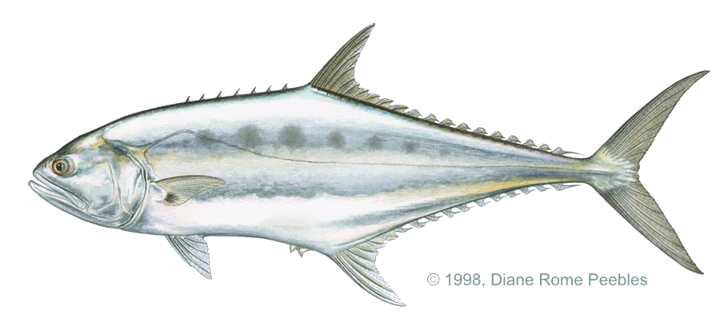Game Fish Identification Reference Guides
Queenfish, talang
(Scomberoides commersonnianus)
(Scomberoides commersonnianus)

Lacepede, 1802; and / Scomberoides lysan (Forsskal, 1775); CARANGIDAE FAMILY; also called leatherskin, spotted leatherskin, giant dart, white fish, skinny fish
The talang and the doublespotted queenfish range widely over the Indo Pacific. The talang has been verified from the Gulf of Thailand, Okinawa, Indonesia, the Philippines, Papua New Guinea, Australia, and the east coast of Africa. The doublespotted has a similar range and also occurs in the Hawaiian Islands, but is unconfirmed in the Gulf of Thailand.
The queenfish has an oblong to elliptical profile with a very short head and a strongly compressed body (from whence the name “skinny fish”. Its lateral line is straight except for a weak, slightly wavy arch over the pectoral fins. The scales are partially embedded. The tail is deeply forked as is typical of carangids and the second dorsal and anal fins are prominent anterior lobes. The first dorsal fin consists of 6 7 short spines with very little visible membrane. The spines are depressible into a groove on the back. The second dorsal fin has one spine and 19 21 soft rays.
The mouth is large on the talang extending well back beyond the eyes. The forehead is slightly rounded (convex) or may have a small bump over the eyes, and the fin lobes are twice as high as in the doublespotted. It has a single row of 5 8 round spots above the lateral line, with the first two possibly touching or intersecting the lateral line.
The doublespotted has a double row of round spots, 5 8 above the lateral line and a parallel row of 5 8 below the line. The mouth extends back only to the back of the eye or scarcely beyond it and the forehead is slightly but noticeably indented.
Both fish are generally dusky green to bluish above, fading to gray, silvery or white below. The high second dorsal and anal fin lobes of the talang are uniformly pigmented (dusky or light) from the body to the tip, whereas in the part of the lobes that extends above the finlets in the doublespotted (the distal half) is distinctly and abruptly darker.
They generally frequent in shore lagoons, reefs, and off shore islands. They may enter estuaries, but the talang does not tolerate low salinity well, nor does it like turbid water. Queenfish are daytime feeders and prefer small pelagic fish, squids, and other fast moving prey. Occasionally they may also feed on crustaceans.
The queenfish is extremely popular as a sport fish and is an excellent fighter on light tackle. Small live baits and trolled lures are preferred. Many anglers say that the coarse flesh is rather tasteless and is better smoked, while others that it is quite good when very fresh. In any event, the leathery skin is best removed before cooking and one should avoid touching the spines of the dorsal and anal fins, as they are poisonous and can inflict very painful wounds
The talang and the doublespotted queenfish range widely over the Indo Pacific. The talang has been verified from the Gulf of Thailand, Okinawa, Indonesia, the Philippines, Papua New Guinea, Australia, and the east coast of Africa. The doublespotted has a similar range and also occurs in the Hawaiian Islands, but is unconfirmed in the Gulf of Thailand.
The queenfish has an oblong to elliptical profile with a very short head and a strongly compressed body (from whence the name “skinny fish”. Its lateral line is straight except for a weak, slightly wavy arch over the pectoral fins. The scales are partially embedded. The tail is deeply forked as is typical of carangids and the second dorsal and anal fins are prominent anterior lobes. The first dorsal fin consists of 6 7 short spines with very little visible membrane. The spines are depressible into a groove on the back. The second dorsal fin has one spine and 19 21 soft rays.
The mouth is large on the talang extending well back beyond the eyes. The forehead is slightly rounded (convex) or may have a small bump over the eyes, and the fin lobes are twice as high as in the doublespotted. It has a single row of 5 8 round spots above the lateral line, with the first two possibly touching or intersecting the lateral line.
The doublespotted has a double row of round spots, 5 8 above the lateral line and a parallel row of 5 8 below the line. The mouth extends back only to the back of the eye or scarcely beyond it and the forehead is slightly but noticeably indented.
Both fish are generally dusky green to bluish above, fading to gray, silvery or white below. The high second dorsal and anal fin lobes of the talang are uniformly pigmented (dusky or light) from the body to the tip, whereas in the part of the lobes that extends above the finlets in the doublespotted (the distal half) is distinctly and abruptly darker.
They generally frequent in shore lagoons, reefs, and off shore islands. They may enter estuaries, but the talang does not tolerate low salinity well, nor does it like turbid water. Queenfish are daytime feeders and prefer small pelagic fish, squids, and other fast moving prey. Occasionally they may also feed on crustaceans.
The queenfish is extremely popular as a sport fish and is an excellent fighter on light tackle. Small live baits and trolled lures are preferred. Many anglers say that the coarse flesh is rather tasteless and is better smoked, while others that it is quite good when very fresh. In any event, the leathery skin is best removed before cooking and one should avoid touching the spines of the dorsal and anal fins, as they are poisonous and can inflict very painful wounds












